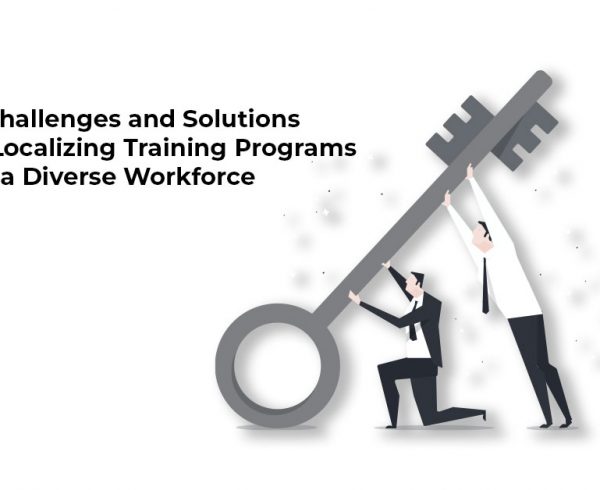Summary
This article showcases the seven key considerations for creating impactful learning experiences. By understanding the various factors that must be considered while localizing training programs across different cultures, you can create impactful learning experiences that are Cross-cultural and relevant to your business.
In today’s interconnected world, businesses are expanding their global presence and reaching diverse audiences. This requires localizing training programs to promote an inclusive, multicultural workspace rather than chasing a one-size-fits-all approach. The demand for localization service companies was valued at USD 4.51 billion in 2021, with a projected growth to USD 6.64 Billion by 2030.
In this article, we will look into seven key considerations businesses must consider while localizing training programs across different cultures. By understanding and addressing various cultural backgrounds, organizations can optimize their business strategies and create impactful learning experiences for all employees. Here are some of the major benefits of localizing training programs.
Table of Contents:
- Benefits of Localizing Training Programs
- 7 Key Considerations for Localizing Training Programs
- Cultural and Language Localization
- eLearning Content Localization
- Involve Local Stakeholders in Training Programs for Higher ROI and Profit Margin
- Centralizing Localization Training for Business Advancement
- Planning for Effective Training Localization
- Understanding the Role of Technology in Localizing Training Programs
- Customized Gamification and Case Study Examples for Cultural Appropriateness
- Conclusion
Benefits of Localizing Training Programs
Explore the need to adopt a multicultural strategy to celebrate diversity at your workplace. Read on to discover the numerous benefits of building culturally inclusive content.
1. Improved Learning Effectiveness
Localizing training programs in the corporate world can significantly improve employee engagement and boost their performance. Cross-cultural training content is adapted to align with different cultures and is preferred by employees as it becomes relevant and relatable to them. Active use of each region’s cultural norms and communication styles leads to increased interest and active participation during training sessions.
2. Improved Cultural Sensitivity
Training programs demonstrating cultural sensitivity and inclusivity within the organization make employees feel respected and valued, fostering a positive work environment. Respecting diverse perspectives encourages employees to embrace differences and collaborate more effectively.
3. Strengthens Global Market Adaptability
Understanding the cultural, legal, and business practices of different regions allows organizations to curate their products and services more effectively. Employees who undergo localization training are better equipped to communicate and negotiate with international partners, leading to more successful business ventures.
Also Read: Exploring the Latest Trends in Localization Technology
7 Key Considerations for Inclusive Training Programs
Acknowledging the numerous benefits of offering the best localizing services in business, here are the seven key considerations that must be considered while localizing training programs across different cultures.
1. Cultural and Language Localization
Corporate training localization programs should be tailored to overcome the cultural and language barriers to help businesses thrive in unchartered territories. This small tip is often overlooked by businesses that strive to earn profits but fail to comprehend the nuances of the local market. The target audience must be studied, and their nativity must be reflected in business strategies.
2. eLearning Content Localization
eLearning content localization has become crucial for international businesses seeking to expand and resonate with their diverse clients off-shore. This strategy helps bridge the difference between multicultural individuals working in different regions. This personalized approach fosters businesses to effectively deliver a unified message to diverse groups that align with cultural contexts, keeping the global workforce contended.
3. Involve Local Stakeholders in Training Programs for Higher ROI and Profit Margin
The role of regional players remains undisputed for a successful global expansion, given their expertise and insights into the cultural, linguistic, and regional details. Local stakeholders can also provide feedback, suggestions, and real-life examples to level up the corporate training localization program.
Local stakeholders in the team can lead to a higher return on investment (ROI) and increased profit margins for the company as they possess a deeper understanding of the region, audience, and market preferences resulting in higher employee engagement and productivity.
4. Centralizing Localization Training for Business Advancement
Centralizing the training program ensures consistency, efficiency and streamlines management across various regions. By consolidating resources, training processes, and expertise in one centralized system, the company can maintain uniformity in content delivery while adapting to the specific local needs in training the team.
This approach to training is cost-effective, facilitates quicker updates, and reduces duplication of efforts to develop diverse regional training content. eLearning localization modules can come into play here, reducing regional barriers in the company and optimizing training quality.
5. Planning for Effective Training Localization
By anticipating the differences in the corporate space, businesses can incorporate relevant local talent that can be used for voice-overs, designing graphics, and integrating local languages in the company briefs to ensure inclusivity amidst their diversity. Thus, conducting thorough research becomes crucial to provide an engaging training program that positively impacts the workspace.
6. Understanding the Role of Technology in Localizing Training Programs
Technology and localizing training programs complement each other, enhancing learning outcomes. Advanced eLearning platforms enable easy content adaptation to cater to diverse cultures and languages. Although we understand that localizing training programs goes beyond mere translation, technology is essential to check for quality-assured content delivery in your local language.
You can now localize your eLearning content with iSpring, Adobe Captive, and Articulate Storyline into globally acceptable formats with ease. Thus, training programs can be fully optimized by harnessing technology’s power and innovative tools.
7. Customized Gamification and Case Study Examples for Cultural Appropriateness
Another way to create an immersive workplace experience is to introduce games, scenarios, and challenges that align with the cultural interests of the participants. These interactive simulations challenge employees to look beyond foreseen circumstances and incorporate their regional understanding in capacity building and problem-solving. This eventually enables employees to navigate diverse business landscapes with ease.
Also Read: 5 Effective Gamification Strategy Tips & Techniques at Work for Enthralling Engagement
Conclusion
These localization strategies are crucial for a successful global venture. Organizations investing trillions of dollars often fail to understand the local markets they need to thrive on. The megatrend of localization is overtaking an increasingly globalized world.
This comprehensive list by Hurix Digital, offering the best multimedia localization services, is all you will need to ensure your business remains inclusive and competitive and caters to your regional workspace demands. With a team of expert localization specialists, we can help adapt your training content to meet diversity requirements easily.
To learn more about our localization and online learning solutions, get in touch with Hurix Digital now.











